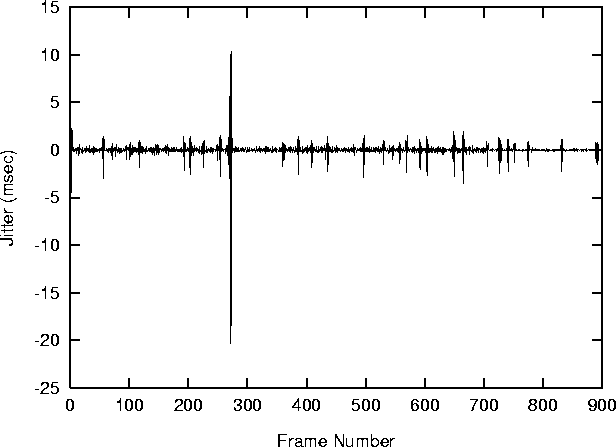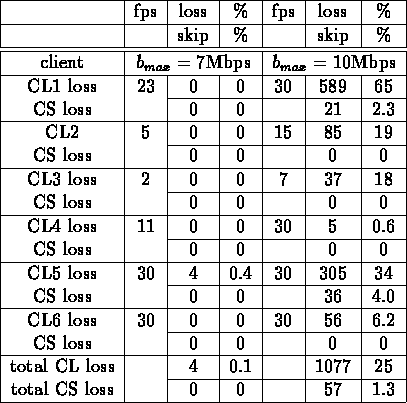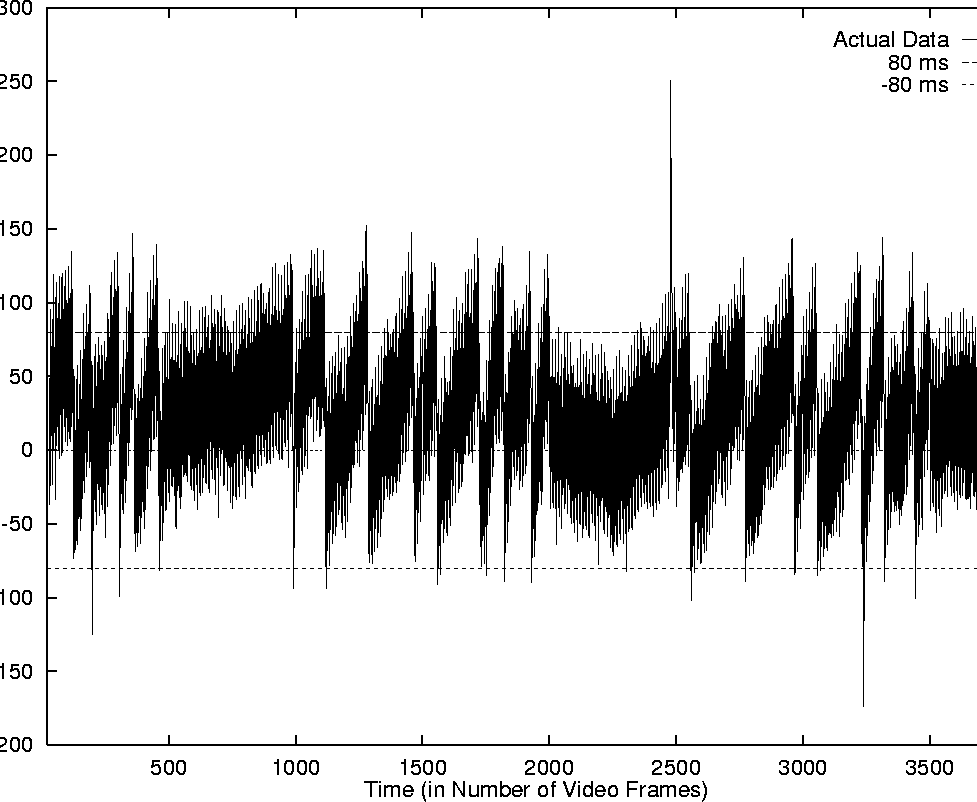
Figure 3: Jitter of Displaying Video Frames
We obtained detailed performance measurements of two VOD systems (the hierarchical VOD system and the remote VCR system) to analyze system overheads and resource consumption dependencies. We use these results to model resource consumption and relations between user satisfaction and resource consumption.
From the hierarchical VOD system we gathered measurements of video jitter and frame loss rate. From the remote VCR system we gathered measurements of synchronization skews between MPEG-compressed audio and video streams. We first describe the experimental workload and then present the results and their conclusion on both systems. With the hierarchical VOD system two major experiments were conducted. The experimental setup was as follows: The experimental LAN was a 10 Mbps Ethernet, the video files were JPEG compressed (320x240), recorded at a rate of 30 fps and displayed at a rate of 30 fps or less using the Parallax JPEG boards. Audio data were in SUN au format of telephone quality. In Experiment 1, we measured video jitter at the VOD client side when there was only one CS on the LAN and the CS served a video stream to a single VOD client. This experiment represented a very light workload. The resulting video jitters are shown in Figure 3.

Figure 3: Jitter of Displaying Video Frames
The CPU resource consumption of the individual threads at the VOD client and CS are shown in Table 1.
The results indicate that this system is capable of providing very high quality video streams for a single VOD client with a short connection setup delay, no out-of-sync errors, no frame losses, low video display jitter and low CPU utilization on the CS. The low CPU consumption on CS indicates the ability of the CS to serve many VOD clients. Higher CPU resource consumption at the VOD client side is largely due to the JPEG decoding thread.
The second experiment (Experiment 2) with the hierarchical VOD system
consisted of supporting multiple VOD client streams from a single CS server.
In this experimental setup, the network bandwidth was managed by the CA.
We set the maximum bandwidth ![]() maintained at CA to 7Mbps and 10Mbps.
When CA assumes
maintained at CA to 7Mbps and 10Mbps.
When CA assumes ![]() 10Mbps, it allowed CS's
(using an admission control mechanism) to send data up to 10Mbps.
Since it is difficult for a 10Mbps Ethernet to provide
100% bandwidth in practice,
congestion was observed when the CS tried to send traffic at
approximately 10Mbps.
The experiment allocated 6 clients requesting the same 30 fps video stream
which is already downloaded in CS.
The results of this experiment concentrated on measuring the frame
loss rate due to increased workloads on the CS. The results of the
experiments measuring frame losses are shown in Table 2.
10Mbps, it allowed CS's
(using an admission control mechanism) to send data up to 10Mbps.
Since it is difficult for a 10Mbps Ethernet to provide
100% bandwidth in practice,
congestion was observed when the CS tried to send traffic at
approximately 10Mbps.
The experiment allocated 6 clients requesting the same 30 fps video stream
which is already downloaded in CS.
The results of this experiment concentrated on measuring the frame
loss rate due to increased workloads on the CS. The results of the
experiments measuring frame losses are shown in Table 2.

Table 2: Frame Losses in Experiment 2
Table 2 shows that when the network is not congested, i.e., the total available bandwidth is bounded by 7 Mbps, then the configuration performs well with low frame loss rates. There are almost no video frame losses. However, the negotiated frame rate delivered to some clients is changed during the admission control process because the CS cannot deliver the requested 30fps to each client. In the case where the available bandwidth is set at 10 Mbps, representing a fully congested network, many video frames are lost. Due to the burst losses, perceptual viewing quality of the video is unacceptably low in this configuration. This implies that the upper bounds for bandwidth resource allocation and consumption are important indicators of user satisfaction.
The third system, the remote VCR system, was analyzed for synchronization
skew performance using the available adaptive synchronization protocol.
In order to guarantee user satisfaction, the desired
synchronization skew between the audio and video streams was required
to be 80ms or lower.
Perceptual studies [26] indicate that
the skews within this boundary are acceptable to the user.
Skews in the range between 80 and 160 ms are tolerable by the user.
Skews larger than 160 ms are
unacceptable and undesirable by the user. Experiments using the adaptive
synchronization protocol within the remote VCR system and the corresponding
results, shown in Figure 4, indicate
that user acceptable or tolerable synchronization performance can be
achieved  .
.

Figure 4: Synchronization Skew. The
characteristics of the video clip are MPEG compressed video with
Pattern:IBPBPBI, size 320x240, rate 7fps, MPEG compressed audio with
layer II encoding and rate 44.1 kHz.
In summary, the hierarchical VOD system and the remote VCR system show that if sufficient resources are reserved, and/or adaptive mechanisms are enforced, user satisfaction can be provided. Based on the experimental results presented here, we see that a weighted correlation between resource consumption and user satisfaction exists; this relationship is modeled in the next section.